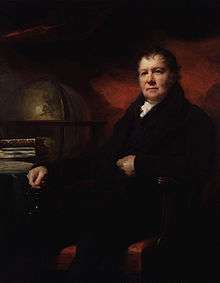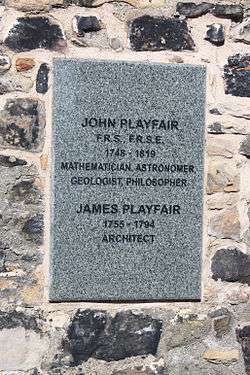John Playfair
| John Playfair | |
|---|---|
 John Playfair – Portrait by Sir Henry Raeburn | |
| Born |
10 March 1748 Benvie, Forfarshire, Scotland |
| Died |
20 July 1819 (aged 71) Burntisland, Fife, Scotland |
| Known for | Playfair's axiom |

John Playfair FRSE, FRS (10 March 1748 – 20 July 1819) was a Scottish scientist and mathematician, and a professor of natural philosophy at the University of Edinburgh. He is perhaps best known for his book Illustrations of the Huttonian Theory of the Earth (1802), which summarised the work of James Hutton.[1] It was through this book that Hutton's principle of uniformitarianism, later taken up by Charles Lyell, first reached a wide audience. Playfair's textbook Elements of Geometry made a brief expression of Euclid's parallel postulate known now as Playfair's axiom.
Early life
Born at Benvie, near Dundee, where his father, Rev James Playfair (d.1772), was a kirk minister.[2]
Playfair was educated at home until the age of fourteen, when he entered the University of St Andrews. In 1766, when only eighteen, he was a candidate for the chair of mathematics in Marischal College (now part of the University of Aberdeen), and, although he was unsuccessful, his claims were admitted to be high.
Six years later he applied for the chair of natural philosophy in his own university, but again without success, and in 1773 he was offered and accepted the benefice of the united parishes of Liff and Benvie, vacant by the death of his father. Playfair continued, however, his mathematical and physical studies, and in 1782 he resigned his charge to become the tutor of Ferguson of Raith. By this arrangement, Playfair was able to be frequently in Edinburgh and to cultivate the literary and scientific society for which it was at that time specially distinguished. In particular, he attended the natural history course of John Walker. Through Nevil Maskelyne, whose acquaintance he had first made in the course of the celebrated Schiehallion experiments in 1774, he also gained access to the scientific circles of London. In 1785 when Dugald Stewart succeeded Ferguson in the Edinburgh chair of moral philosophy, Playfair succeeded the former in that of mathematics.
Mature work


In 1795 Playfair published an alternative, more stringent formulation of Euclid's parallel postulate, which is now called Playfair's axiom. Although the axiom bears Playfair's name, he did not create it, but credited others, in particular William Ludlam, with its prior use.[3]
In 1802, Playfair published his celebrated volume entitled Illustrations of the Huttonian Theory of the Earth. The influence exerted by James Hutton on the development of geology is thought to be largely due to its publication. In 1805 Playfair exchanged the chair of mathematics for that of natural philosophy in succession to John Robison, whom also he succeeded as general secretary to the Royal Society of Edinburgh. He took a prominent part, on the liberal side, in the ecclesiastical controversy that arose in connection with Sir John Leslie's appointment to the post he had vacated, and published a satirical letter (1806).
Playfair was an opponent of Gottfried Leibniz's vis viva principle, an early version of the conservation of energy. In 1808, he launched an attack[4] on John Smeaton and William Hyde Wollaston's work championing the theory.
Family
John's brothers were architect James Playfair, solicitor Robert Playfair and engineer William Playfair. His nephew, William Henry Playfair (1790–1857) was an eminent architect in Scotland. Although an eminent man, Playfair was buried in an unmarked grave in Old Calton Burial Ground, on Waterloo Place in Edinburgh. His, and his brother, James's graves were marked by a plaque unveiled in 2011 following a local campaign.[5] The monument to his memory by William Henry Playfair, on Calton Hill,[6] is visible from the spot. In later life he admired and proposed to the wealthy widow Jane Apreece. She turned him down and married the younger and more famous Sir Humphry Davy.[7]
Honours
- Fellow of the Royal Society of Edinburgh
- Fellow of the Royal Society of London, 1807
- Craters on Mars and the Moon were named in his honour.
- The mineral playfairite was named in his honour.[8][9]
Critical bibliography
A four-volume collected edition of Playfair's works, with a memoir by James G. Playfair, appeared at Edinburgh in 1822.[10]
His writings include a number of essays contributed to the Edinburgh Review from 1804 onwards, various papers in the Philosophical Transactions of the Royal Society (including his earliest publication, "On the Arithmetic of Impossible Quantities", 1779, and an "Account of the Lithological Survey of Schehallion", 1811) and in the Transactions of the Royal Society of Edinburgh ("On the Causes which Affect the Accuracy of Barometrical Measurements" and others), the articles "Aepinus" and "Physical Astronomy", and a "Dissertation on the Progress of Mathematical and Physical Science since the Revival of Learning in Europe" in the Encyclopædia Britannica (Supplement to fourth, fifth and sixth editions).
His Elements of Geometry first appeared in 1795 and has passed through many editions; his Outlines of Natural Philosophy (2 vols., 1812–1816) consist of the propositions and formulae which were the basis of his class lectures. Playfair's contributions to pure mathematics were not considerable, his papers "On the Arithmetic of Impossible Quantities" and "On the Causes which Affect the Accuracy of Barometrical Measurements", and his Elements of Geometry, all already referred to, being the most important. His lives of Matthew Stewart, Hutton, and Robison, many of his reviews, and above all his "Dissertation" are of the utmost value.
Notes
- ↑ Playfair, John (1802). Illustration of the Huttonian Theory. Edinburgh: Cadell & Davies – via Internet Archive.
- ↑ http://www.royalsoced.org.uk/cms/files/fellows/biographical_index/fells_indexp2.pdf
- ↑ J. Playfair and Euclid, Elements of geometry; containing the first six books of Euclid, with two books on the geometry of solids. To which are added, elements of plane and spherical trigonometry, J.B. Lippincott & Co, 1860, p. 291. Available online from Google Books. See also Cajori's A History of Mathematics.
- ↑ Edinburgh Review, 12, 1808, 120–130
- ↑ http://www.ewht.org.uk/news/183/102/Fitting-tribute-to-a-distinguished-man
- ↑ Biographical Dictionary of Eminent Scotsmen (1856), reproduced in Significant Scots
- ↑ Sophie Forgan, ‘Davy , Jane, Lady Davy (1780–1855)’, Oxford Dictionary of National Biography, Oxford University Press, 2004; online edn, May 2008 accessed 17 Dec 2014
- ↑ Information about Playfairite on Mindat database, Retrieved on 19 April 2012.
- ↑ J.L. Jambor (1967) New lead sulfantimonides from Madoc, Ontario; Part 2, Mineral descriptions, Canadian Mineralogist, vol. 9, 194–6
- ↑ See the Collected Works of John Playfair on the Internet Archive (www.archive.org)
External links
- Dictionary of Scientific Biography
- O'Connor, John J.; Robertson, Edmund F., "John Playfair", MacTutor History of Mathematics archive, University of St Andrews.
- Significant Scots: John Playfair
- National Portrait Gallery
- John Playfair (1836) Elements of Geometry from Google books, see page 22 for parallel axiom.
- Works by or about John Playfair in libraries (WorldCat catalog)
- From the Linda Hall Library
- Playfair's (1802) Illustrations of the Huttonian Theory of the Earth
- Playfair's (1815) Explication de Playfair sur la théorie de la terre par Hutton
![]() This article incorporates text from a publication now in the public domain: Chisholm, Hugh, ed. (1911). "Playfair, John". Encyclopædia Britannica. 21 (11th ed.). Cambridge University Press. p. 831.
This article incorporates text from a publication now in the public domain: Chisholm, Hugh, ed. (1911). "Playfair, John". Encyclopædia Britannica. 21 (11th ed.). Cambridge University Press. p. 831.